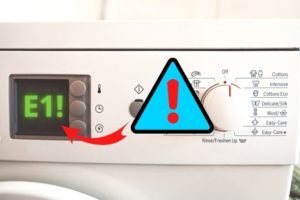
Essentially, the E1 error code on a GE washing machine indicates a problem with the water supply to the unit. Imagine trying to fill a glass with water, but the faucet is barely trickling. That’s somewhat what’s happening inside your washer. It’s not getting the amount of water it needs to run a proper cycle. This could be due to several issues, ranging from a kink in the hose to a more complex internal malfunction. But no worries, we’ll dive into that and make it all crystal clear.
So, what’s the plan here? First, let’s break down what could cause this little hiccup in your laundry routine. We’ll also cover how to troubleshoot and fix these issues, bringing your washing machine back to life. Think of it like being a washing machine detective, solving the mystery one step at a time.
Understanding the E1 Error Code
First things first, let’s decipher this cryptic E1 error. The E1 code typically signals an issue with the water supply to your washing machine. In essence, your washer is akin to a person needing water to stay hydrated—as simple as that. If it doesn’t get enough water, it can’t function properly. This might stem from a lack of water pressure, a blocked or kinked hose, or even a defective inlet valve that’s not letting water flow as it should.
You might be wondering, “Why is water pressure such a big deal?” Well, think of it like trying to fill an inflatable pool with a small trickle from a garden hose. It’ll take forever, and quite frankly, it’s not efficient. Similarly, for your washer, insufficient water means it can’t perform its tasks, like washing and rinsing, which rely heavily on an adequate water supply.
Now, let’s talk about those pesky hoses. If they’re twisted or blocked, water can’t flow through them properly. It’s like trying to drink through a straw that’s kinked—nothing’s getting through. Similarly, a failing water inlet valve, which acts like a gatekeeper, might not be opening enough to let sufficient water pass through. This is where things get a bit technical, but don’t worry, I’ve got you covered with some simple solutions coming up next.
Troubleshooting the E1 Error Code
Alright, here’s the deal. Once you see the E1 error, it’s time to roll up your sleeves and start the troubleshooting process. It’s not as daunting as it sounds. Think of it like a little DIY project you can tackle on a lazy afternoon. Start with the simplest checks—your water supply. Ensure the water tap connected to your machine is fully open. Sounds basic, but sometimes, the simplest oversight can cause the biggest headaches.
Next, inspect the hoses. Make sure they’re connected properly and check if they’re crimped or bent. A simple straightening out might just solve the entire issue. If the hoses are clogged, disconnect them and give them a good rinse to clear any blockages. Imagine cleaning out a straw that’s blocked with paper bits—it’s the same idea.
Then, consider the water inlet valve. If it’s malfunctioning, it could be the root cause of the problem. You might want to consult a professional if you’re not comfortable handling this on your own. But, if you’re up for it, replacing a faulty valve isn’t too complex once you get the hang of it. It’s just like swapping out a faulty tap—you’ll be amazed at how much you can do with the right video tutorial and a bit of patience.
Getting Professional Help and Preventative Measures
So, what if you’ve tried your best, and the E1 code still won’t budge? Well, that’s when calling in a professional can save you time and stress. Sometimes, there could be underlying issues that aren’t immediately apparent, like an internal sensor malfunction or a more delicate electronic issue. A trained technician will have the right tools and experience to diagnose and fix the problem efficiently, ensuring your washing machine is as good as new.
In the long run, taking some preventative measures can keep these errors at bay. Regularly checking and maintaining the water pressure, as well as keeping the hoses clear of any obstructions, can go a long way. Think of it like regular check-ups for your car. It keeps everything running smoothly and prevents small issues from snowballing into bigger, more expensive problems.
And finally, a little tip: periodically cleaning your washing machine can also aid in preventing such errors. It’s like giving your machine a little TLC to keep it in top shape. Besides, a clean machine not only performs better but also extends its lifespan, giving you more loads of clean laundry without the hiccups.
By understanding the E1 error code and knowing how to respond, you’re now better equipped to handle these little laundry-day curveballs with confidence. Happy washing!